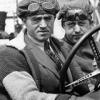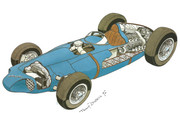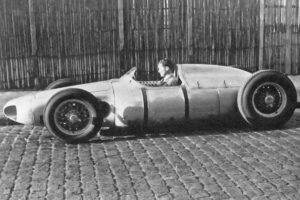
The Cisitalia-Porsche story had an early sequel in the fifties. An engineer named Vigna had studied at the Porsche Office, and he gained backing from the French film producer Sacha Gordine to build a series of major-Formula racing cars, which he based on Cisitalia experience.
Sacha Gordine was an extremely wealthy man. He was then in his early forties, and had made his name as a film producer after shooting his first movie clandestinely during the German occupation. Post-war he made films with stars such as Simone Signoret and Jean Gabin, and two of his perhaps more famous titles were La Ronde and Black Orpheus.
He was a great motoring enthusiast and was a regular rally competitor with his wife. He wanted a modern Grand Prix car which would put France back on the racing map, for although Amédée Gordini’s cars were performing miraculous feats in comparison to their shoestring budget, their French blue was very much subordi-nated to Italian red.
So Gordine set-up his racing car company at 154 Rue Danton, Levallois-Perret (Seine) and to avoid confusion with his compatriot, Gordini, he hyphenated his names to christen the project Sacha-Gordine.
Simultaneously the French government were back on their national racing car bandwagon, Messrs Chaban-Delmas, Flandin, Puy and Gaubert urging a 250,000,000 franc budget for the construction of a French car ‘... capable de représenter nos couleurs et de défendre nos intérêts dans les competitions internationales, avec une chance sérieuse de succès . . .’. After the SEFAC and the CTA-Arsenal they were choosing their words well!
Sacha-Gordine, however, was self-financing, and in January 1953 the first car was virtually complete and the press were shown round the Levallois workshops.
Vigna’s design owed much to the ill-fated Cissy’s layout, but it was much lighter and smaller, creating a sensation at the time because hardly any part of the bodywork stood higher than the tyres!

The Sacha-Gordine chassis was a very simple ladder-frame, with two straight tubular side members joined by cross-pieces and carrying a light superstructure of thin tubing to support the body panels.
Front suspension, like the Cisitalia, was by parallel trailing links, sprung by transverse torsion bars mounted in the chassis cross-members. A De Dion axle was used at the rear, sprung on longitudinal torsion bars housed within the main chassis longerons.
Vigna seems to have had a free hand with the budget, for he used extremely expensive magnesium castings everywhere in the engine and transmission, and all over the rear suspension.
The De Dion tube was itself in magnesium, was located by a ball joint tiding in a vertical slide housed in the magnesium final drive casing, and was located fore-and-aft by twin cast magnesium radius arms running forward to the chassis on either side. Even the brake back-plates and air-scoops were formed in magnesium.
The engine was a 90-degree V8 unit with cylinder dimensions of 70 x 64mm giving a Formula 2 capacity of 1,970cc. The crankcase, base chamber, cylinder blocks and heads were all cast in magnesium alloy, and the steel wet liners were extensively finned just like an air-cooled cylinder barrel.
Combustion chambers were hemispherical, carrying two valves at an included angle of 90-degrees actuated from twin overhead cam-shafts per bank. Again in similar style to the Cisitalia, the camshafts were shaft driven.
A one-piece crankshaft was used running in Vandervell shell bearings, and dry sump lubrication was employed with a double oil pump in the engine’s extensively finned base chamber. In unsuper-charged Formula 2 trim the Sacha-Gordine carried four double-choke carburettors. Single spark plugs per cylinder were fired by a single Vertex Scintilla magneto, and glycol cooling was used with twin pumps driven from the camshafts.
The mid-mounted engine drove rearwards through a twin dry-plate clutch (in a magnesium housing) to a five-speed gearbox mounted transversely accepting drive through a central bevel pinion. A splined output shaft carried a transfer gear in a separate casing which could easily be changed to match the final drive ratio to any given circuit. Jointed half-shafts drove from a differential assembly to the rear wheels. Like the Cisitalia a motorcycle style gearchange was used, with each gear being engaged in sequence, if only momentarily, as the driver changed up or down.
Nostril intakes formed in the car’s bodywork fed air into two large ducts which fed through two small radiators and then discharged through outlets just behind the front wheels. An oil cooler, oil tank, rack-and-pinion steering gear and glycol header tank filled the front end of the chassis, while massive pannier tanks were slung on either side of the cockpit offering a combined capacity of 66 gallons. Each tank was attached by two straps and could be easily detached from the chassis to give maintenance access.
Vast drum brakes were mounted on the wheels, sixteen inches in diameter at the front and fourteen at the rear, with four leading shoes and operated by independent hydraulic circuits front and rear. The wire wheels were themselves seventeen inches in diameter with an optional eighteen inch size at the rear, and the new car’s smooth, flat bodyshell with its nostril air intakes and thrust forward, eager appearance (heightened by the stub tail being tucked down between the rear wheels) looked terrific, slung low between those tall Dunlop tyres.
Vigna and development engineer Perkins (a Frenchman of Siamese descent) were also working on 1,500cc, 2,500cc and 4,500cc versions of the V8 engine, with the 1.5-litre carrying twin Roots superchargers for Formula 1. A Le Mans car was projected, to use a special three litre version of the Sacha-Gordine engine, and a twin-tube chassis frame was mocked-up for this mid-engined vehicle, alongside five single-seaters!
Claims were made that the 1.5-litre Formula 1 engine was to have a 22:1 compression ratio, which would require ‘iso-octane’ fuel. Boost pressure for this engine was claimed to be 57lbs but I believe the unit was never to be completed. Vigna also intended to adopt a Hirth-type crankshaft with roller bearings in each of his engines. Power output for the virtually complete Formula 2 car was quoted as 191bhp at 8,000rpm, and the new Sacha-Gordine’s dimensions were released as wheelbase, 8ft 5.5ins; front track 4ft 5.1ins; rear track 4ft 4ins and dry weight 1,400lbs. Vigna hazarded a Formula 1 supercharged engine output of over 380bhp at 8,000rpm.
This staggeringly ambitious project had two cars virtually complete in early 1953, and one was entered for the Pau Grand Prix at Easter, but suddenly Sacha Gordine realised that his fortune was fast dribbling away — he wrote off the whole project as a tax loss and it foundered as abruptly as it had begun.
Denis Jenkinson tells me that for years there was a story that the two virtually complete cars were stored in a factory park on an island in the Seine, and if one could find the proper vantage point the cars could be seen clearly. Evidently the story died a natural death about ten or twelve years ago, and nobody now seems to know where the Sacha-Gordines disappeared to.




















